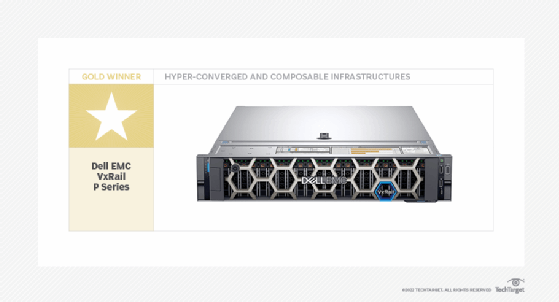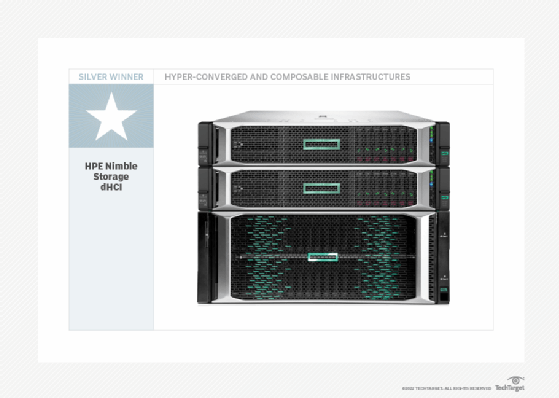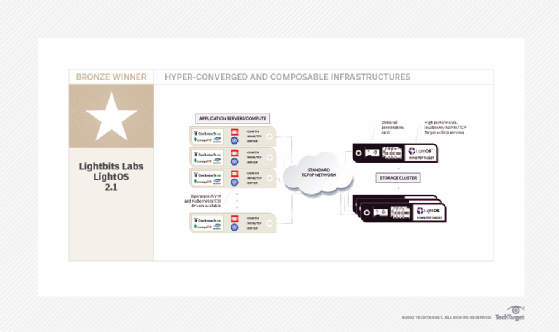
stock.adobe.com
The top hyper-converged systems and composable infrastructure of 2021
These Products of the Year winners offer the flexibility and scalability that make hyper-converged systems an excellent choice for companies of any size.
To say hyper-converged systems have radically changed data center operations borders on understatement. Networked storage altered the data center landscape in the transition from mainframe to distributed computing. However, hyper-converged and composable infrastructure products have effectively reimagined data storage architectures by releasing the storage management software layer from its hardware moorings and using the power of advanced microprocessors.
Evolved from converged systems that featured pre-racked server, storage and networking components, these software-driven systems took convergence to a new level by virtualizing all the hardware elements. This development significantly reduced dependence on a single vendor's gear and offered a level of flexibility that was previously unachievable.
Hyper-converged systems are typically based on commercial off-the-shelf servers and commodity storage media. That building block approach provides unprecedented scalability, enabling users to add storage or compute power as needed with the software making the appropriate adjustments to the overall configuration.
Nutanix -- a 2011 winner in the storage systems category -- is something of a poster child for hyper-converged infrastructure as one of the first vendors to roll out an HCI product. Today, customers would be hard-pressed to find a storage or systems vendor without HCI systems in its product portfolio. First considered workgroup platforms, hyper-converged systems can now meet the most stringent requirements of critical enterprise applications.
But perhaps the best indicator of how the technology has grown are the number of software-only products available today. Hyper-converged systems and composable infrastructure software is so sophisticated and easy to use, it has spawned a DIY following of IT pros who roll their own HCI environments.
This year's Products of the Year medalists for hyper-converged systems and composable infrastructures include both hardware-plus-software combos and software-only offerings. And as testament to the strength of these technologies and the market, winners include heavyweights Dell EMC and HPE that have been active in HCI development for years and a relative newcomer, startup Lightbits Labs.
These three vendors epitomize the direction and strength of hyper-converged systems. They added features and increased ease of use with new capabilities such as improved modularity that enables independent scaling of compute power and storage capacity, as well as upgrades to management software.
Gold winner: Dell EMC VxRail P Series
Dell EMC VxRail is a Products of the Year oddity: a repeat gold medal winner from last year, when a previous version topped this category. VxRail's back-to-back golds represent a first for this key product category.
Dell wasn't the first systems vendor to roll out an HCI offering, but by flexing its EMC and VMware muscle and using its well-established PowerEdge server expertise, it can now boast one of the top HCI product lines available. With the help of its VMware Cloud Foundation SDDC Manager, VxRail creates a nearly seamless link between the HCI environment and cloud-based resources.
The VxRail line of hardware and software offers a wide choice of nodes with varying compute resources, capacities and capabilities. "Dell provides an end-to-end portfolio across the HCI segment," one judge noted. The current version adds nodes built around the latest generation of Intel Xeon processors, which provide 42% more cores than previous processors and 50% more PCIe slots to handle new network cards. And VxRail nodes now support VMware vSAN HCI Mesh, which enables independent scaling of storage and compute.

The Dell EMC VxRail P Series has also beefed up its management capabilities to provide automated implementations, scaling and service, as well as additional security features, such as the ability to manage third-party network interface cards and automated system health checks.
One judge said this iteration of VxRail included "a lot of hardware upgrades, but also a lot of software ones too -- definitely a major upgrade." Another judge remarked that "Dell's VxRail continues to define the HCI category, with Dell and VMware continuing to drive the innovation forward."
Silver winner: HPE Nimble Storage dHCI
HPE's winning hyper-converged offering -- like Dell's -- taps the company's extensive server experience, pairing that compute expertise with technologies it gained from a couple of its acquisitions. With its 2017 acquisition of Nimble Storage, HPE pocketed InfoSight software, a suite of advanced analytics and resource management tools, which HPE puts to good use in its Nimble Storage dHCI silver medal winner. Prior to HPE's acquisition, Nimble garnered gold in the 2016 storage systems: all-flash systems category, silver in the 2016 storage systems: disk and hybrid systems category and bronze in the 2014 storage systems: disk and hybrid systems category of the Products of the Year awards. InfoSight now uses AI as the basis of its predictive analytics and performance tuning.
Another 2017 acquisition, SimpliVity, gave HPE a significant jump-start on its development of HCI software and has become a key part of its HCI product line built around its ProLiant servers. HPE claims its software riding atop its powerful servers can deliver sub-millisecond latency for the type of performance required to support critical enterprise applications.

The latest version of HPE's Nimble Storage dHCI adds support for all-NVMe configurations that require high-performance storage. "Low latency and high availability are key features of storage systems," one judge commented. "And HPE Nimble Storage provides both."
HPE has also enhanced the networking components of Nimble Storage dHCI using automation the company said "radically simplifies deployment" of the hyper-converged system. The network automation is extensive, including virtual LAN switch configuration and cabling verification. The level of automation impressed another of our judges, who noted that "the networking automation is a very nice addition that reduces admin workloads noticeably."
Bronze winner: Lightbits Labs LightOS 2.1
This year's bronze award winner in the hyper-converged and composable infrastructures category is Lightbits Labs Ltd. for its LightOS 2.1, a newcomer to the HCI field that's already shaking up the industry with its innovative NVMe/TCP networking. This 5-year-old startup, with offices in Israel, Silicon Valley and New York City, is backed by investments from industry icons, including Cisco, Dell EMC, Intel and Micron.
The LightOS software runs on commodity servers and uses standard TCP/IP networking to support a clustered block storage system using NVMe media. Its use of Ethernet as its internal transport simplifies data center networking by not introducing another networking protocol into the environment. This makes Lightbits one of the earliest implementers of NVMe/TCP technology. "Lightbits Labs is ahead of the curve with its technology," one judge said, "giving innovative enterprises a path to a high-performance software-defined future."

LightOS 2.1 adds advanced point-in-time snapshotting capabilities, which enable the creation of thin clones, cloned volumes that can be fashioned out of snapshots. The snapshots and clones can be used with Kubernetes containers and OpenStack cloud environments. This version also adds multi-tenancy features that enable users to slice up resources on a project or application basis.
"The solution offers native NVMe/TCP and can run applications on bare metal, in containers or in virtual machines, delivering them over standard TCP/IP networks," one judge noted.
LightOS is a standalone software product, but it's also offered as a pre-installed appliance called Lightbits SuperSSD the company said is plug-and-play.
Learn who made the podium in all five of the Storage magazine and SearchStorage 2021 Products of the Year categories.







